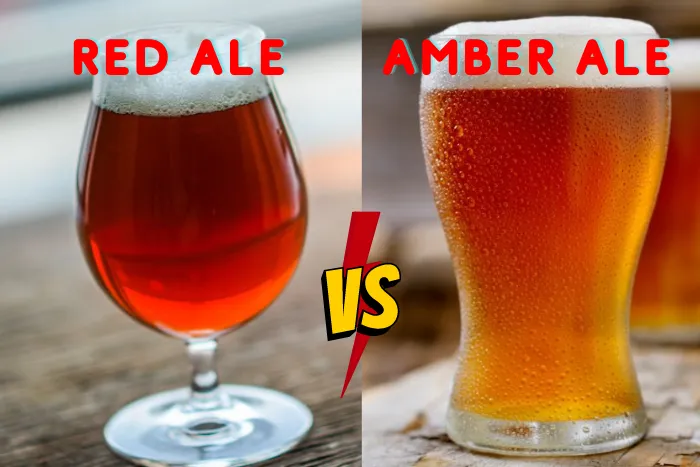Are you curious about the amber ale vs. red ale beers? From their origins to fermentation processes, flavor profiles, colors, and alcohol content – there’s a lot to explore. Amber ales have been around since the 1700s, while red ales are a recent invention.
Let’s dive deeper into this topic of amber ale vs. red ale and see what makes each beer unique. We’ll discuss ingredients used for brewing, taste notes of both types of beer, and famous brands that readers should try out. So grab your favorite pint glass – it’s time for an adventure through two delicious craft brews.
Table of Contents:
- Origins and History of Amber Ale and Red Ale
- Ingredients, Fermentation, and Brewing Process for Amber Ale and Red Ale
- Flavor Profile, Color, Alcohol Content, IBU, and Health Impact of Amber Ale vs Red Ale Beers
- Popular Brands of Amber Ale vs Popular Brands of Red Ale Beers to Try Out.
- FAQs in Relation to Amber Ale vs Red Ale
- Conclusion
Origins and History of Amber Ale and Red Ale

Amber Ale and Red Ale are the oldest brews, boasting a long-standing tradition. Both beers have been brewed for centuries, although their origins remain somewhat mysterious.
Origin of Amber Ale:
Amber ales date back to at least the 1700s in England, where they were known as “mild” or “pale ale” beers. The term “amber” was first used to describe these beers in 1842 when Bass Brewery introduced its famous pale ale called “Bass No 1”. This style has since become one of the most popular types of beer worldwide.
Origin of Red Ale:
Red ales originated in Ireland during the late 1800s. They were initially called “red porters” due to their dark color and intense flavor profile resembling a traditional Irish porter beer. Over time, red ales evolved into a distinct style characterized by an amber-red hue and sweet maltiness from roasted barley malts.
Historically speaking, both amber ale and red ale had significant roles in shaping modern brewing practices today. For example, many brewers credit Bass’ pale ale as instrumental in developing new techniques for producing lighter-colored beers without sacrificing flavor or complexity – something that would eventually lead to other light lagers becoming more widely available worldwide.
Similarly, red ales helped introduce consumers to new flavors, such as caramelized malts, while introducing them to different brewing methods like dry hopping, a practice that is now commonly found across all craft beer styles today.
Ingredients, Fermentation, and Brewing Process for Amber Ale and Red Ale
In both (Amber and Red) Ales, ingredients, fermenting, and brewing processes vary significantly.
Ingredients Used in Amber Ales:
Amber ales typically use a combination of pale malts, such as Maris Otter or Vienna malt, along with darker crystal malts for color and flavor. Hops like Cascade, Centennial, or Chinook often provide bitterness and aroma. Other ingredients may include wheat, oats, honey, spices, fruits, herbs, or other adjuncts.
Ingredients Used in Red Ales:
Red ales usually have a pale malt base supplemented with caramel malts for color and flavor. Popular hop varieties used in red ale recipes include Willamette and Fuggle hops which provide earthy notes to the beer’s overall profile.
Depending on the brewer’s preference, other ingredients, such as chocolate malt or roasted barley, can be added for additional complexity of flavors while still maintaining its distinctive reddish hue from the specialty grains used during the mashing process.
Fermentation Process for Amber Ales & Red Ales:
Fermenting amber ales requires a warm temperature range between 65-68 degrees Fahrenheit (18-20 Celsius). It allows yeast strains like California Ale Yeast (WLP001) or London Ale Yeast (WLP013) to produce an array of fruity esters, including apple aromas and subtle hints of clove spice character that define this style perfectly.
On the other hand, fermenting red ales needs cooler temperatures, around 60-64 degrees Fahrenheit (15-17 Celsius). Commonly recommended yeast strains include Nottingham Ale Yeast (Danstar), American Ale II Yeast (White Labs WLP051), and Kolsch Yeast (Wyeast 2565). These strains produce a light fruitiness balanced by low levels of diacetyl, giving the beer a clean finish when fermented correctly.
The ingredients, fermentation process, and brewing process of amber and red ales vary significantly regarding flavor profile, color, alcohol content, IBU levels, and health impact. We will now contrast the tastes of these two brews to decide which is more suited for a given situation.
Flavor Profile, Color, Alcohol Content, IBU, and Health Impact of Amber Ale vs Red Ale Beers

Both have distinct flavor profiles, colors, alcohol content, international bitterness units (IBU), and health impacts. Let’s take a closer look at each to understand how they differ.
Tase and Color Comparison of Amber and Red Ale
Amber ales typically have a more malty flavor with caramel nuances, whereas reds are hoppier and display fruity hints. Amber ales are orange-brown, while red ales boast a deep ruby hue.
Alcohol content in Amber and Red Ale
Regarding alcohol strength, both brews typically possess a 5% ABV or more significantly, although this may be contingent on the specific beer and its producer.
IBU in Amber and Red Ale
International Bitterness Units (IBU) for these beers can range from 20-50 for amber ales and 15-35 for red ales – meaning that amber will usually be slightly more bitter than its counterpart due to higher hop levels in the brewing process.
Health Impact of Amber and Red Ale
Regarding health impact, there isn’t much difference between the two; however, drinking any alcoholic beverage should always be done in moderation as excessive consumption can lead to serious health issues over time, such as liver damage or addiction problems.
Popular Brands of Amber Ale Beers
There are many brands of amber ales available for beer enthusiasts. Some popular brands include Sierra Nevada’s Northern Hemisphere Harvest, Bell’s Amber Ale, and Founders Red’s Rye PA.
These beers typically have a malty sweetness with notes of caramel and toast that make them incredibly drinkable. Typically boasting an ABV of 4-6%, these beers provide a great way to enjoy without worrying about becoming overly intoxicated.
Popular Brands of Red Ale Beers
Regarding red ale beers, some popular brands include Firestone Walker DBA, Stone Brewing Co.’s Arrogant Bastard Ale, and New Belgium Fat Tire Amber Ale. These beers have a more robust flavor with dark fruit notes and roasted malts, resulting in their red-tinged hue and an ABV that typically falls between 5-7%. The ABV on these ales tends to range from 5-7%.
Amber or red ales tend to be less bitter than other styles like IPAs or stouts, but they still have enough flavor complexity for craft beer experts who want something more interesting than a standard lager or pilsner.
FAQs in Relation to Amber Ale vs Red Ale
What makes an amber ale red?
Amber ales possess a characteristic orange-red tint, resulting from malts roasted at an elevated temperature during brewing. This color comes from the malts used in its brewing process, which are kilned at higher temperatures than those used for other types of beers.
The longer roasting time and higher temperature create melanoidins, which gives off red hues when combined with hops and yeast during fermentation. Amber ales have a malty sweetness balanced by hop bitterness, making them popular among craft beer drinkers.
What’s the difference between amber and ale?
Amber and Ale are two different types of beer. Amber beers are reddish-brown, while Ales are golden or light brown. Regarding flavor, Amber beers usually have a malty sweetness with hints of caramel, nuts, and toast.
In contrast, Ales typically feature fruity esters like citrus or floral notes alongside some maltiness. Amber beers typically contain 4%-6% ABV, whereas Ales are usually in the range of 5%-7%. Ultimately, the differences between these two styles come down to their distinct colors, flavors, and alcohol content.
What makes a red ale a red ale?
Red ales get their hue from various malts such as crystal, caramel, and chocolate which produce shades of red ranging from light copper to deep ruby. The most common malts used are crystal, caramel, and chocolate, which all impart different shades of red, ranging from soft copper to deep ruby.
Red ales typically have an earthy flavor profile with notes of sweet caramel or toffee and subtle hop bitterness. These medium-bodied beers have low carbonation levels making them smooth and easy to drink.
What’s the difference between an amber ale and a brown ale?
Amber and brown ales are both types of beer that share similar characteristics, but there are some key differences. Amber ales are a bit lighter than brown ales, with an amber hue. They also have a sweeter flavor profile than the nutty, roasted flavors in a brown ale.
Regarding alcohol content, amber ales typically range from 4-6% ABV while most brown ales range from 4-7%. Generally speaking, amber ale is more approachable for those just getting into craft beers due to its lower bitterness and milder flavor profile.
Conclusion
To summarize, amber and red ales are two distinct brews with unique flavor profiles. Both can be enjoyed for a variety of reasons. Still, it’s essential to understand how they’re made, where they come from, what ingredients are used in the fermentation and brewing processes, how dark the color is, how much alcohol is in them, how bitter they are, and how they affect your health. A wide variety of popular brands are available on the market today for each type, so make sure you try out some amber ales and red ales to see which one best suits your taste.
Discover the best amber and red ales with our expert reviews, find out how to make your beer at home with our guides, and join a craft beer subscription service to deliver unique brews regularly. Let Brew Publik help you explore the world of craft beers!
Also See: Sour Beer Nutrition Facts: Everything You Need to Know
